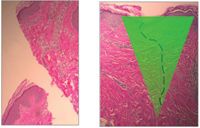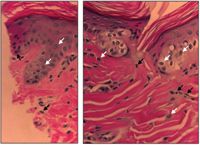- General Dermatology
- Eczema
- Chronic Hand Eczema
- Alopecia
- Aesthetics
- Vitiligo
- COVID-19
- Actinic Keratosis
- Precision Medicine and Biologics
- Rare Disease
- Wound Care
- Rosacea
- Psoriasis
- Psoriatic Arthritis
- Atopic Dermatitis
- Melasma
- NP and PA
- Skin Cancer
- Hidradenitis Suppurativa
- Drug Watch
- Pigmentary Disorders
- Acne
- Pediatric Dermatology
- Practice Management
- Prurigo Nodularis
Article
Photochemical tissue bonding could be substitute for sutures
Photochemical tissue binding using green light and a common diagnostic dye could provide a safe, effective and simple substitute for sutures in superficial skin closures and other applications, says an expert.
Boston - Photochemical tissue bonding (PTB) using green light and a common ophthalmologic dye appears safe and effective for superficial skin closures and could provide a quick, simple substitute for sutures in this application and others, an expert says.
"PTB is potentially a way to seal surgical incisions or excisions in skin using green light and a photoactivatable dye," says Irene E. Kochevar, Ph.D., professor of dermatology, Harvard Medical School and Wellman Center for Photomedicine at Massachusetts General Hospital.
PTB can eliminate the need for sutures on superficial closures, she says. While the procedure still requires intradermal sutures, Dr. Kochevar notes, "It offers a number of advantages. First, the patient doesn't have to return for suture removal."

Reviewing the basics
Basic steps of this procedure include drawing the two sides of a wound together with intradermal sutures, then placing the dye into the wound, applying transparent surgical tape over the wound and exposing the wound to green light for approximately two minutes.
Recent research supports a photochemical rather than photothermal mechanism for PTB [Lasers Surg Med. 2005 Oct;37(4):264-270]. In this study, investigators used green light from a continuous wave, frequency-doubled Nd:YAG laser (Compass 415M-500, Coherent) to test PTB with Rose Bengal dye (RB; Aldrich Chemical Company) against closure methods, such as sutures and tissue adhesive, in a pig model. Even with chilled-air cooling, which eliminates a thermal mechanism, PTB performed as effectively as conventional sutures in terms of cosmetic outcomes and histology.
Subsequent research addressed a concern about the phototoxicity of green-light activated PTB.
More specifically, Dr. Kochevar says that although RB is widely used for diagnostic ocular staining, "We know that if one uses RB with green light on cells grown in culture, the cells will die."
Combining RB and green light creates reactive oxygen species that are highly toxic to cultured cells, she explains. To determine whether this is likely to happen with human skin in vivo, Dr. Kochevar and her colleague Robert Redmond, Ph.D., also of Harvard and the Wellman Center, tested the combination of green light and RB on neonatal human dermal fibroblasts grown in a tissue culture monolayer, and those grown in a collagen gel that approximates human skin.






